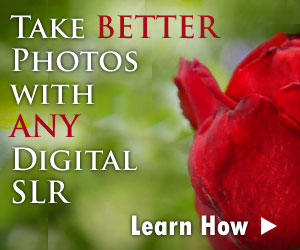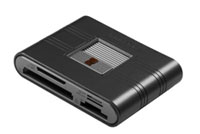Digital SLR Memory Cards
Digital SLR memory cards are an essential accessory.
In fact, it's a bit ridiculous to call them an accessory: they are a necessity.
You can't take a single photo without one, and memory cards are not included in the box with your digital SLR camera.
Since you have to purchase your digital SLR memory separately, there are two questions that you need to answer:
- How MUCH memory do you need?
- How FAST should the card read and write information?
Compact Flash and SD Memory
There are two types of digital SLR memory cards, and the camera you buy will dictate which card you use.
Compact Flash
Compact Flash cards are small squares, about half the size of a credit card and 5 times as thick.
For years, Compact Flash cards were the only memory cards used by digital SLR cameras.
This proved beneficial for consumers: the tough competition in the market lowered the price of these cards and increased their storage capacity by leaps and bounds.
While a 1 GigaByte (GB) card used to be impressive, today you can get them up to 32GB.
SD Memory
As manufacturers move toward SLR cameras that are smaller and lighter, they want to to do anything to reduce the weight.
While Compact Flash cards don't weight a ton, they are not as small and light as SD memory cards — an SD card is about the size of a postage stamp and almost as thin.
Here's the advantage: many compact cameras and other portable devices also use SD cards as a source of memory.
Now you can get just one SD card and use it for your MP3 player, compact digital camera and digital SLR.
Storage Capacity
The capacity of digital SLR memory cards is measured in MegaBytes (MB).
For the non computer-literate, a MegaByte is a measurement of capacity on a computer hard drive or other storage device.
The more megapixels you camera has, the more MegaBytes each photo uses on your digital SLR memory card.
Once you get up to 1024 MB, you've got a GigaByte (GB).
This means that a 8GB card is equivalent to 4096 MB of storage space, which is quite a lot unless you take hundreds of pictures a day or enjoy vacations that last several weeks.
How Much Storage Do You Need?
You've decided on a camera and now you're shopping for digital SLR memory cards.
Where to begin?
The first decision that you'll have to make is how much memory you'll need.
This depends a lot on how long you want to use the camera before transferring photos off the card to a more permanent storage space (i.e. your computer's hard drive).
Short Trips - 8GB
Short trips require more memory if you're not close to a computer for a couple of days.
In these cases, all the photos you take will have to remain on the memory card.
If you fill the card up, then it's just like running out of film - except you can't buy memory cards at the corner drugstore.
Long Vacations - 16GB or More
When you're prone to taking long vacations away from electronic devices, then the more memory the better.
Several 1GB and 2GB cards should keep you covered for some time.
The amount of memory that you need is clearly dependent on the number of photos you take.
If you're not happy-snappy, then you won't need a ton of memory no matter how much time you spend on travel.
'Round The World - Digital Photo Storage
There's an alternative for the long vacation set if you don't want to buy a ton of digital SLR memory cards.
Take a look at some digital photo storage devices — they range in capacity from 20 to 40 GigaBytes. You can insert your SD or Compact Flash card and transfer photos from the card to the portable device.
If you don't already own a laptop that goes with you everywhere (since that serves the same purpose) then a digital photo storage device might be just what you need.
Memory Card Speed
Once you've decided on the capacity of your digital SLR memory card, you have to choose a speed.
Memory card speed is required for two things:
- When the camera saves a photo to the card
- When you transfer photos from card to computer
Faster is usually better with digital SLR cameras, but fast speeds increase the price of a card (and the top speed of a fast memory card is only leveraged by the most modern digital SLR).
This is why you can find two cards with the same amount of storage space with radically different prices.
Check the speed - one is probably a faster than the other.
Memory Card Tips
I have several tips for you about how to use your digital SLR memory card.
These tips come from personal experience taking a lot of photos, both close to a computer and on long vacations.
Get Several Cards With Less Storage
I recommend that you get several cards with less storage rather than a single card with a huge storage capacity.
For example, get two 8GB cards instead of one 16GB card.
What's the point of this? Why not get cards with the highest capacity that you can afford?
Memory cards are like other computer parts: they can break down. Should your memory card fail catastrophically, would you rather lose 300 photos or 600?
Format Cards After Each Use
When you get all the photos copied from your memory card to your computer, format the card.
If you don't know how to do this on your computer, just use the menu setting on your digital SLR camera to do it.
Formatting the card permanently clears it of all information.
This ensures that you're starting with a clean card when you take more photos with your camera.
While you can just delete the images on the card (without reformatting) this can sometimes leave residual information on the card that increases the chance of memory card failure.
Formatting is the sure-fire way to ensure that your cards work perfectly all the time.
Memory Card Readers
I am convinced that these are the most useful digital SLR camera accessories.
A memory card reader plugs into the USB port of your personal computer permanently.
Can you transfer photos from camera to computer without one? Of course: you just have to plug the camera into the computer every time that you want to do it.
With a memory card reader, you just take the memory card out of your camera, pop it int the reader, transfer photos, reformat, and then pop the card back in your camera.
It's a very convient way to get photos onto your computer so you can review them.
Two options to consider here are the Kingston 19-in-1 USB 2.0 Flash Memory Card Reader or the Transcend 15-in-1 USB 2.0 Flash Memory Card Reader
.
| Digital SLR Home | Digital SLR Batteries |

|






